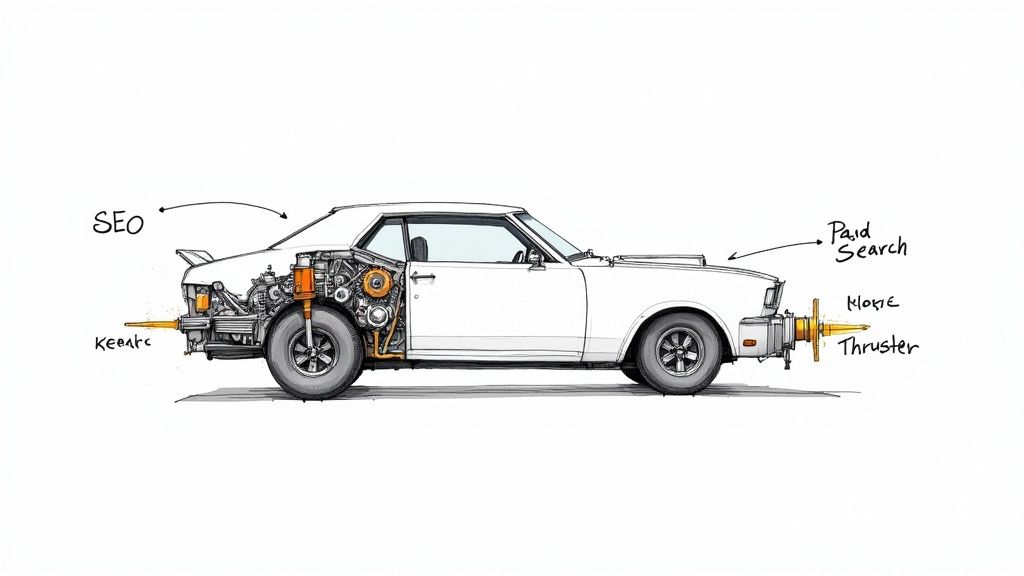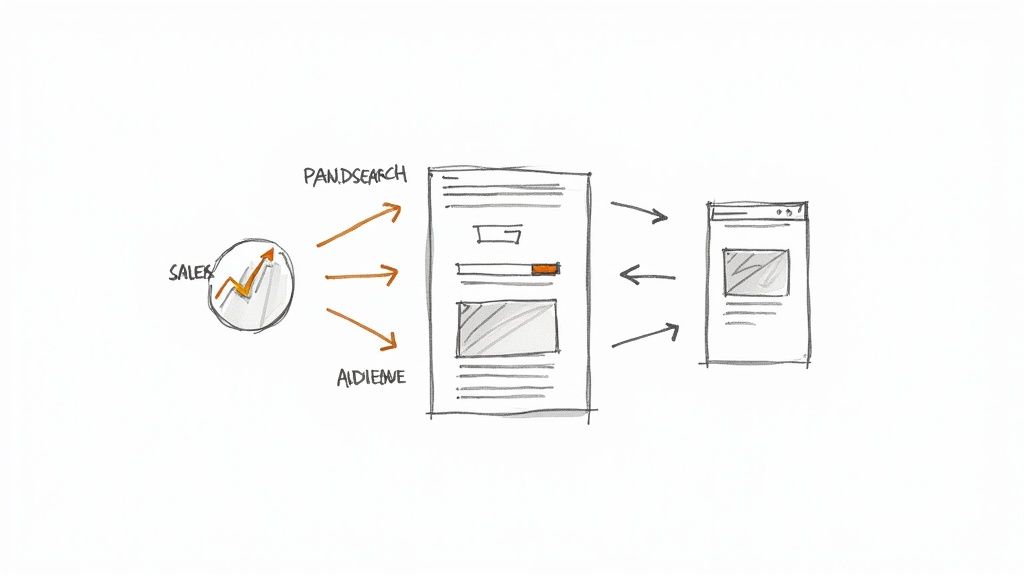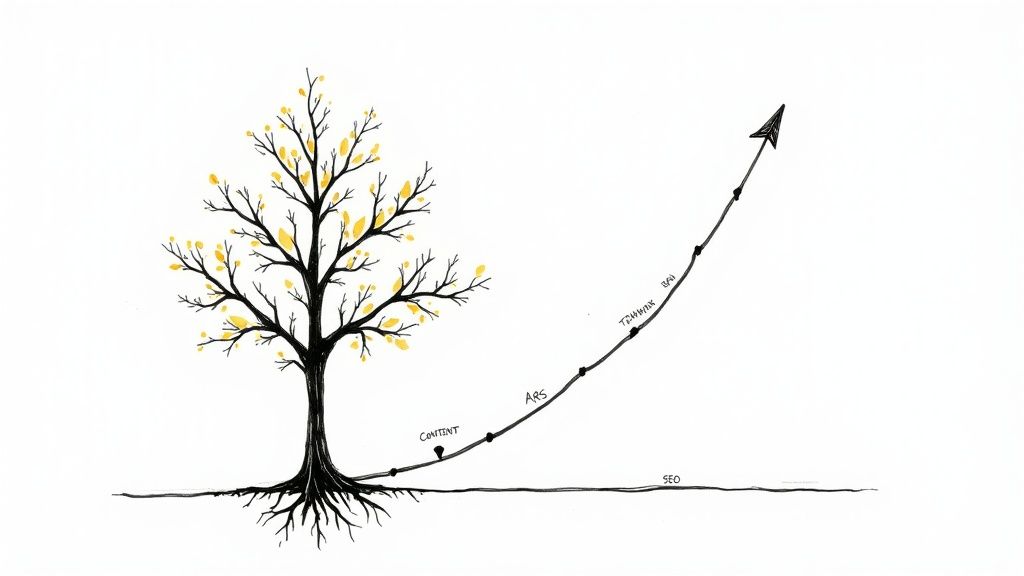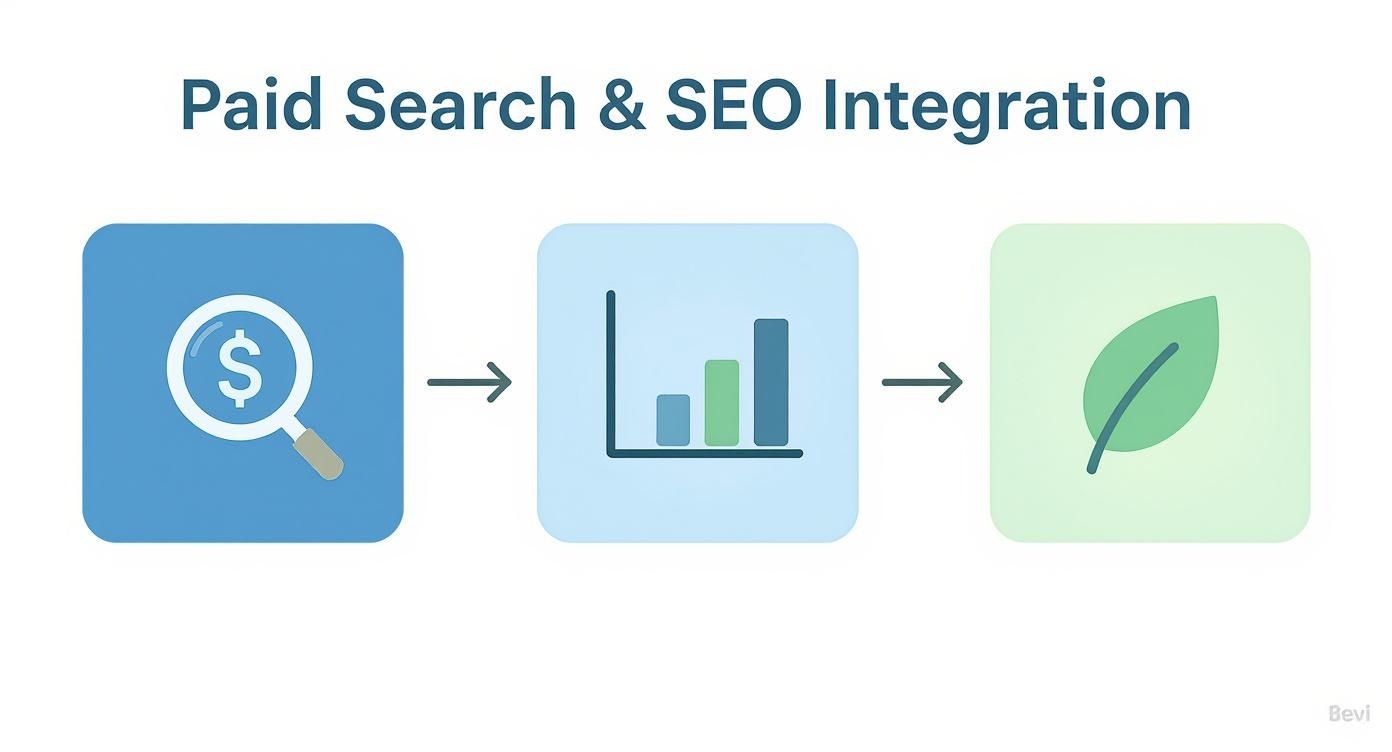When you boil it down, the difference between paid search and organic search is pretty straightforward: paid search via Google Ads is like buying a front-row seat, while SEO is about earning that spot over time.
Think of it this way: a Google Ads campaign is like renting a massive, flashy billboard on the busiest digital highway. It gets you immediate, targeted attention. SEO, on the other hand, is like building such a fantastic, must-visit destination that Google naturally sends people your way. To truly dominate the search results page (SERP), you need both working in tandem within the Google ecosystem.
The Two Engines Driving Your Google Ads Success

Let's imagine your digital marketing is a high-performance race car. To win the race for customer attention on Google, you need two different but equally important engines working together.
The first engine is Paid Search, powered by the Google Ads platform. This is your turbo boost—it gives you an instant, powerful surge of visibility. When you launch a Google Ads campaign, you can appear at the very top of the search results almost instantly. This is perfect for driving highly qualified traffic to your site right now, especially for high-intent keywords.
Your second engine is Search Engine Optimization (SEO). Think of this as your masterfully tuned, incredibly efficient main engine. It's not about instant acceleration; it's about building sustainable, reliable authority for the long haul. A solid SEO strategy builds your website's trust with Google's algorithm, attracting a steady flow of high-quality organic traffic that doesn't cost you per click.
Why You Shouldn't Choose—You Should Use Both
Too many businesses get caught up in the "Google Ads vs. SEO" debate, but that’s the wrong way to look at it. The smartest brands know these aren't opposing forces. They're two parts of a powerful acquisition machine. When you combine them, you dominate the search results from every angle. For a more detailed breakdown, check out our guide on paid vs. natural search.
Here's a quick look at how these two powerhouses compare.
Paid Search vs SEO At a Glance
| Attribute | Paid Search (Google Ads) | SEO (Organic Search) |
|---|---|---|
| Speed to Results | Immediate | Long-term (months) |
| Cost | Direct cost per click (CPC) | Indirect (content, tools, time) |
| Placement | Top of the page (ad section) | Below ads (organic results) |
| Traffic Longevity | Stops when you stop paying | Sustainable, long-lasting |
| Targeting | Highly specific (demographics, location, device) | Broader, based on search intent |
| Testing Ability | Fast and easy to A/B test ad copy & landing pages | Slow, requires patience |
As you can see, they each have their strengths. The real magic happens when you stop seeing them as separate and start using them together.
The true power comes from making Google Ads and SEO work in tandem. Data from your PPC campaigns can supercharge your SEO strategy, and strong organic rankings can improve your ad Quality Score, lowering your costs.
When you integrate them, you create a marketing engine that’s both incredibly fast and built to last. This powerful combination helps you:
- Own the SERP: By appearing in both the paid and organic sections, you maximize your visibility and literally push your competitors further down the page.
- Get Smarter with Data: Use the instant feedback from Google Ads to see which keywords and ad copy convert best. Then, use those proven winners to guide your long-term SEO content strategy.
- Build Unshakeable Authority: Showing up in both paid and organic results signals to users that you're a serious, credible leader in your industry. It builds immense trust.
Paid Search: Your Fast Pass to the Top of Google

Think of paid search through the Google Ads ecosystem as your direct line to instant visibility. It’s like buying a VIP ticket that lets you skip the long queue and go straight to the front row—right at the top of Google’s search results. Instead of waiting for months for SEO to kick in, you decide exactly who sees your ads, when they see them, and what message you want to send.
This is what makes Google Ads so powerful. You can bid on keywords that signal high buying intent, targeting people who are actively looking for a solution like yours. This precision means your marketing dollars go toward reaching an audience that’s not just window shopping, but is ready to convert.
What Makes a Winning Google Ads Campaign?
A great Google Ads campaign isn't just about throwing money at keywords. It’s a finely-tuned machine where every single part works in harmony to drive conversions. The real goal isn't just getting clicks; it's about getting the right clicks that turn into actual customers at an acceptable cost.
For your campaign to really succeed, three key elements need to be perfectly in sync:
- Smart Keyword Bidding: You target the exact phrases your best customers are searching for, leveraging bidding strategies like Target CPA or Maximize Conversions to let Google's AI optimize your spend.
- Irresistible Ad Copy: Your ad needs to stop scrollers in their tracks. It has to clearly and quickly communicate your unique value proposition, making that click a no-brainer. Responsive Search Ads (RSAs) are key here, allowing Google to mix and match headlines and descriptions to find the winning combination.
- High-Converting Landing Pages: After the click, the journey has to be seamless. The landing page must deliver on the ad's promise and make it incredibly easy for the visitor to take the next step, directly impacting your Quality Score.
To really get a handle on this, understanding the common pitfalls and success strategies for Google Ads PPC campaigns is key to maximizing your return on ad spend (ROAS).
Google Ads is more than just an advertising channel—it's a real-time market research lab. It gives you instant, practical data on what keywords work, which headlines resonate, and what offers drive action.
This is why a staggering 98% of marketers rate Google Ads as the most trustworthy paid channel. The numbers don't lie: traffic from PPC ads converts about 50% better than organic traffic, on average. These campaigns can also increase brand awareness by as much as 80%, making Google Ads a must-have for both immediate leads and building a long-term presence.
At the end of the day, Google Ads gives you incredible speed and control. It’s the perfect engine for testing new offers, launching products, or simply creating a reliable flow of leads. The insights you pull from a well-managed campaign are gold, giving you the data to sharpen not just your ads, but your entire marketing approach.
Building Long-Term Authority with SEO

Alright, let's switch gears and talk about the other side of the coin: Search Engine Optimization. If Google Ads is like renting a billboard on a busy highway, SEO is like building and owning the most respected building on Main Street. It's a long-game strategy, one where you methodically earn trust with both Google's algorithm and your audience. The result? A rock-solid asset that keeps paying you back for years.
The traffic you get from SEO is often called "free," but that's not the whole story. It requires a serious investment of time, expertise, and resources. The magic is that once you've earned a top spot, every click you get doesn't cost you a penny. This is how you build a real foundation of authority and break free from being totally dependent on your Google Ads budget.
The Three Pillars of Modern SEO
To build that kind of lasting reputation with search engines, you have to nail three core areas. Think of them as the pillars holding up your entire digital presence. If one is shaky, the whole thing can come tumbling down.
-
On-Page SEO (Valuable Content): This is all about the quality of what’s actually on your website. We’re talking about creating genuinely helpful, in-depth content that answers the real questions your customers are asking. When you target the right keywords and provide true value, you’re sending a clear signal to Google that you know your stuff.
-
Off-Page SEO (Digital Credibility): This covers how you’re seen across the rest of the internet. The biggest piece of this puzzle is backlinks—links pointing to your site from other respected websites. Think of every quality backlink as a vote of confidence, telling Google that other experts trust what you have to say.
-
Technical SEO (User-Friendly Foundation): This pillar makes sure your website is a breeze for both search engine crawlers and actual humans to navigate. A site that loads quickly, works perfectly on mobile, and has a logical layout is absolutely essential. Google prioritizes sites that provide a good user experience, making this a critical ranking factor.
Earning Trust Over Time
Let's be clear: SEO is a marathon, not a sprint. While paid search gets you on the map instantly, a smart SEO strategy builds momentum that compounds over time. The data doesn't lie—research consistently shows that organic search drives the lion's share of all website traffic, often accounting for over 53% of visits compared to just 15% from paid search. That stat alone shows you the massive long-term payoff of earning your spot.
SEO is really about being helpful at scale. Google's entire mission is to give its users the most relevant, trustworthy answers. When you create content that truly helps your ideal customer solve a problem, Google rewards you with a steady stream of high-intent traffic.
This gradual, trust-building process creates a powerful digital footprint. When people find you naturally in the search results, it builds a different kind of trust than seeing an ad. It signals that you’ve earned that position through sheer expertise.
This is where the real magic happens. The synergy between paid search and SEO is what the best marketers use to dominate the search page and build unshakeable brand authority. The trust you build with SEO actually makes your entire marketing engine run better, including your Google Ads.
Your Playbook for Integrating Google Ads and SEO
Look, Google Ads and SEO are great on their own. But when you get them to work together, something special happens. They start feeding off each other, creating a cycle where each one makes the other stronger. This isn't just some marketing theory—it's how you actually start to own your space online and get more out of every dollar you spend in the Google Ads ecosystem.
Think of it as a conversation with your market. Your Google Ads are asking, "Hey, what are you looking for right now?" and your SEO strategy is listening intently, using those answers to build a permanent library of content that shows you're the expert. This interplay is the secret to a truly smart search strategy.
Use Paid Data to Fuel Your SEO Content
Want to know the fastest way to figure out what your audience actually cares about? Stop guessing and start looking at your Google Ads data. Your paid search campaigns are a real-time market research lab, telling you which keywords don't just get clicks, but actually turn into real business. This is pure gold for your SEO team.
Instead of throwing content at the wall and hoping it sticks, you can build your entire content plan around keywords you already know work.
- Find Your Winners: Jump into your Google Ads account and check the "Search terms" report. Look for the queries with the best click-through and conversion rates. These are the topics your ideal customers are raising their hands for.
- Build Content That Matters: Take those proven search terms and make them the cornerstone of your blog posts, guides, and landing pages. If "24/7 emergency hvac repair" is your best-performing ad group, then writing a comprehensive guide on handling an HVAC emergency is a no-brainer for SEO.
- Go After Long-Tail Keywords: Your ad data will also uncover longer, more specific phrases people are searching for. Use these "long-tail" keywords to create super-focused content that answers niche questions and catches people who are much closer to making a decision.
Dominate the SERPs with a Two-Pronged Attack
Let's be real: ranking for a big, competitive keyword takes time. You can't just sit around and wait to be seen. While your SEO efforts are climbing the ladder, Google Ads can provide the perfect air cover. By running ads for those high-value terms, you get instant visibility at the top of the page.
This way, you're grabbing traffic from day one. And there's a psychological bonus, too. When a potential customer sees your brand in both the paid and organic results, it builds a massive amount of trust. It signals that you're not just a player; you're a leader.
The official Google Ads platform is built for this kind of immediate impact. Its dashboard is all about driving results now—website visits, calls, and foot traffic. That's exactly why it works so well alongside a patient, long-term SEO strategy.
Retarget Organic Visitors to Close the Deal
Hard truth: not everyone who finds you through a Google search is ready to buy right away. They might just be doing their homework, comparing you to competitors, or they might just get distracted. Without a plan to bring them back, that valuable organic traffic is gone for good.
This is where remarketing in Google Ads is a game-changer.
By using paid ads to reconnect with people who found you through SEO, you can gently pull them back to your site. You can show them ads that tackle their specific concerns, offer a special discount, or simply remind them why you were the right choice in the first place.
Paid search is still one of the most effective ways to get in front of the right people. Across most industries, search ads see an average click-through rate (CTR) of around 3.17% and a conversion rate of 2.55%. You can check out more insights on paid search advertising trends to see just how well this works. A well-placed remarketing ad can be the final nudge that turns a curious visitor into a loyal customer.
How to Measure What Truly Matters
When you blend paid search and SEO, you need a way to measure success that goes beyond the obvious numbers. Just looking at cost-per-click (CPC) in Google Ads or keyword rankings in your SEO tool is like judging a movie by watching a single scene. You're completely missing the bigger story.
To really get a feel for how well your strategy is working, you need to shift your focus from channel-specific stats to real business outcomes. It’s about tracking the numbers that actually hit your bottom line.
Beyond Clicks and Rankings
Great measurement is all about seeing how your Google Ads and organic efforts team up to drive actual growth. Stop thinking of them as separate channels and start tracking the metrics that show their combined power. You want to see the entire customer journey, from their first search query to the moment they convert.
Here are a few metrics that truly matter:
- Total Search-Driven Conversions: Add up all the leads and sales from both your paid ads and organic listings. This number shows you the real impact of your total search presence.
- Blended Customer Acquisition Cost (CAC): Instead of calculating CAC for each channel separately, combine them. This gives you a much more honest look at what it costs to land a new customer through search.
- Share of Voice: How often does your brand appear on page one of Google for your most important keywords? This includes both paid ads and organic results, giving you a holistic view of your visibility.
This infographic breaks down how the data you get from paid search campaigns can directly feed and strengthen your SEO strategy over the long haul.

The key takeaway? Paid search gives you instant, usable data that you can immediately put to work to fuel sustainable organic growth.
Tying It All to ROI
At the end of the day, there's only one question that really counts: is this strategy making you money? The only way to know for sure is by carefully measuring your marketing ROI.
When you link up your efforts in Google Analytics and Google Search Console, you can start to see how people bounce between your paid ads and organic results on their way to becoming a customer.
This unified view helps you prove the total value of your search marketing program. It gives you the confidence to make smarter decisions about where to put your Google Ads budget to get the biggest bang for your buck, ensuring every dollar is pulling its weight.
What's Next for Google Ads and Search?
If you want to stay ahead in search marketing, you have to keep one eye on the future. The Google Ads ecosystem is constantly being reshaped by new tech and user behavior, making a blended strategy more important than ever. The biggest game-changer? Artificial Intelligence (AI). It's not just a buzzword; it's already here and making a huge impact.
Take Google Ads, for example. AI is fueling a massive push toward automation. Think of advanced campaigns like Performance Max (PMax), which uses machine learning to automatically handle bids, targeting, and even creative elements across all of Google's channels (Search, Display, YouTube, Gmail, etc.). This frees you up to focus on big-picture strategy instead of getting lost in manual tweaks.
At the same time, AI is making SEO smarter. Google’s Search Generative Experience (SGE) is changing how results are displayed, integrating AI-powered snapshots directly into the SERP. This means high-quality, authoritative content is more critical than ever to be featured.
Getting Ready for New Ways to Search
People aren't just typing into a search bar anymore. The way we look for information is expanding, and as marketers, we have to keep up to stay visible. These new search habits are opening up fresh avenues for Google Ads and SEO.
A couple of key formats you need to have on your radar include:
- Voice Search: With every home getting a smart speaker and every phone having a digital assistant, optimizing for natural, conversational questions is becoming a must.
- Visual Search: Tools like Google Lens let people search using their camera, pointing at something to find out what it is or where to buy it. This is a massive opportunity, especially for e-commerce.
A smooth, intuitive user experience isn't just a nice bonus anymore—it's the price of entry. Google rewards sites that are fast, easy to navigate, and genuinely helpful, regardless of whether someone clicked on a paid ad or an organic link. This directly impacts your Ad Rank and organic rankings.
All these technological shifts just hammer home the need for a unified paid search and SEO strategy. Looking ahead, the global search advertising market is expected to hit a staggering $351.5 billion in spending by 2025. That number tells a story: businesses are leaning more and more on paid channels to drive growth.
A huge part of that growth is coming from our phones. In fact, 61% of all search ad spending is projected to come from mobile devices by 2029. You can dig into more stats about the future of PPC spending on mailmodo.com. Staying on top of these trends isn’t just about being competitive; it’s about making sure your business is ready for whatever comes next.
Still Have Questions? Here Are Some Quick Answers
Getting the hang of how paid search and SEO play together can be tricky. Let's clear up a few of the most common questions that pop up when you're building out your Google Ads and SEO strategy.
My Budget Is Tight. Should I Start with Paid Search or SEO?
This is the classic chicken-or-egg question for a lot of businesses. If you need to see traffic and leads coming in the door right now, then a focused paid search campaign on Google Ads is your best bet. It’s the fastest way to get results and start gathering data on what works.
That said, don't put SEO on the back burner completely. Think of it as a long-term investment. Start working on the SEO basics from day one so you can slowly build a valuable asset that eventually won't cost you a penny for each click.
How Long Until I Actually See SEO Working?
Let’s be real: SEO is a marathon, not a sprint. It takes patience. You might spot a few small wins in a couple of weeks, but you’re typically looking at 4 to 6 months before you see a real, measurable impact on your traffic and rankings.
Of course, this isn't a hard-and-fast rule. The timeline can change depending on how competitive your industry is, the current health of your website, and how much effort you're putting in.
Can I Just Run Google Ads and Ignore SEO for Now?
Absolutely. You can fire up a Google Ads campaign and start driving traffic even if your website's SEO is a work in progress. The two systems are separate, so one doesn't technically require the other to function.
But there's a catch. Google's Quality Score is a huge factor in how much you pay per click and where your ads show up. A big piece of that score is your landing page experience. If your site has technical SEO issues—like it's slow to load or isn't mobile-friendly—your Quality Score will suffer. That means you'll pay more for less effective ads. So, while you can run them separately, they always work better together.
Stop missing out on hot leads from your Google Ads campaigns. With Pushmylead, you can get your lead form data from Search, Discovery, and YouTube ads sent straight to your inbox the moment they come in. No more manual downloads means you can respond to potential customers instantly. Find out more and get started with Pushmylead.
